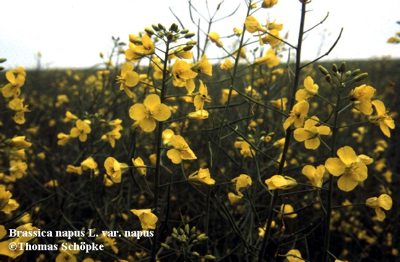Crops
Brassica napus L. ssp. olifera Moench - Annual rape
Taxonomic position.
Family Brassicaceae Burnett, genus Brassica L.Forms: biennis - winter rape, annual - spring-sowed rape.
Biology and morphology.
Annual plant with narrow tap root. Stalk straight, rounded, height 0.3 - 1.5 m, branched, covered with a thin wax coat, glaucous-green or grey-violet color. Lower leaves lyre-shaped, pinnate-incision, rarely hairy, with leafstalks. The final blade of the bottom leaf is large, blunt-oval, on edge anisodentate; lateral blades (from 2 up to 4 pairs) small, oval or blunt-triangular. Stem leaves hastate. Top leaves lanceolate, with an expanded base covering stalk. The inflorescence cluster contains from 20 to 40 flowers. Flowers are rather large, yellow, pedicels from 1.4 to 2.5 cm. Petal length from 9 to 18 mm. Internal stamens are 7-10 mm long, upright; external 5.0-8.5 mm long. Fruit is a narrow pod, 5-10 cm long, 3-4 mm wide. Pod contains 15-30 seeds, 1.5-2.5 mm in diameter and is gray-black, orbicular or spherical shaped. Weight of 1000 seeds is 3-4 (7) g. 2n=38.Ecology.
This is a long day species. This plant requires moisture, especially during the initial stage of growth. This species does not like to be water-logged. Soil requirements: prefers chernozems, but will yield successfully in loamy, sandy soils. Entomophilous. It can be both cross and self-pollinated. Spring-sown rape is less demanding of soil-climatic conditions and therefore it is used widely compared to winter varieties. Vegetation period of winter rape is 250-265 days, of spring-sown rape, 90-110 days. Species is used as a hay-crop 60-70 days after the start of the vegetative period.Distribution.
Wild species are not known. This species originated as a natural cross between leaf and field cabbages. It has been cultivated for 4000 years. In Europe it first appeared in England and Holland, and in the second half of the sixteenth century it appeared in Germany, then Poland to Ukraine (in 1836) and into Russia. It is cultivated up to the northern boundaries limits of the Leningrad and Kirov areas. The border of economic distribution is 55 degrees of northern latitude. In the seventies, the oil seed crop was cultivated on 607 thousand hectares (180 thousand hectares occupied by winter varieties) in the Ukraine, Byelorussia, the Baltic States, Black Earth Region, Northern Caucasus, Kazakhstan, Non-Black Earth Region, Karelia, West and East Siberia. As a fodder crop it has been cultivated on about 100 thousand hectares. Main cultivars include: Sintinsky, VEM, Promin., Tismenitsky, Otradninsky, Kontakt, Oniks - winter rape; Evvin, Kubansky, Kovalevsky, Shpat, Zolotonivsky, Vikros, Oredezh 1, Yarvelon - spring-sow rape.Utilization and Economic Value.
This species yields valuable oil and is used as fodder. Seeds contain 20% protein, 17-18% carbohydrates, and 43-50% semidrying oils, which are used directly in food, for production of margarine, and also in the metallurgical, paint and varnish, soap-manufacturing, and textile industries. Oil contains a significant amount of erucidic acid, which is used by the chemical industry to manufacture high-quality nylon, although highly erucidic acid-types produce oil that is not suitable for food use. There are new varieties without erucidic acid (Snitskiy, VEM), which are use to produce food-grade oil. As fodder, oil-cake is used in forage mixes. Vegetation is rich in ascorbic acid and carotene and has a similar feed value as vetch-oat mixes. In combination with other plants, it is included in silage forages. Rape contains glucosinolates, which decrease the quality of forage and therefore new cultivars have been developed that do not contain glucosinolates. There are also varieties that have been developed that contain no erucidic acid, no glucacinolates, have less cellulose and yellow seeds. Rape is a good honey plant. This is a good plant to use in rotation of crops after cereals, and perennial grasses. It is sown in either narrow or wide rows, with 13-15 to 6-8 kg per hectare, respectively. Mowing begins during the stage of yellow-green ripeness, when seed moisture is 30-33%. Productivity of winter rape is 2-2.9 ton seeds per hectare; for spring-sow rape it is 1.2-1.8 ton seeds per hectare; green mass reaches 35-40 ton per hectare and more.Reference citations:
Artemov I.V. 1989. Rape. Moscow: Agropromizdat. 43 p.Gortlevsky A.A., Makeev V.A. 1983. Winter sorts of rape. Moscow: Rossel.hozizdat. 136 p.
Kazancev V.P. 2001. Rape, charlock and radish. Oil-yielding crops in Siberia. Novosibirsk. 116 p.
Korenev G.V. 1990. Plant Growing with Basics of Selection and Seed Growing. Moscow: Agropromizdat. 574 p.
Malahov G.N. 1986. Rape-high yield growing. Cheljabinsk: Yuzhno-Ural.skoe knizhnoe izdatel.stvo. 40 p.
Mishurova V.P., Volkova G.A., Portnjagina N.V. 1999. Introduction of useful plants in subzone of middle taiga of Komi Republic. V. 1. St. Petersburg.
Niklyaeva V.S., ed. 1990. Basics of Agriculture and Plant Growing. Moscow: Agropromizdat. 478 p.
Shtan'ko A.V. 1958. Cultivation of Rape in Karelia Conditions. Academic Transactions of Petrozavodsk University. Biological and Agricultural Sciences (Biologicheskie i sel'skohozyaistvennye nauki), 9(3): 67-69.
Vehov V.N., Gubanov I.A., Lebedeva G.F. 1978. The cultivated plants of the USSR. Moscow: Mysl.. 336 pp. (In Russian)
Vul.f, E.V., ed. 1941. Cultural Flora of USSR. V. 7. Moscow-Leningrad: 496 p.
Zhukovskii P.M. 1971. Cultural Plants and their Relatives. Leningrad: Kolos. 751 p.


